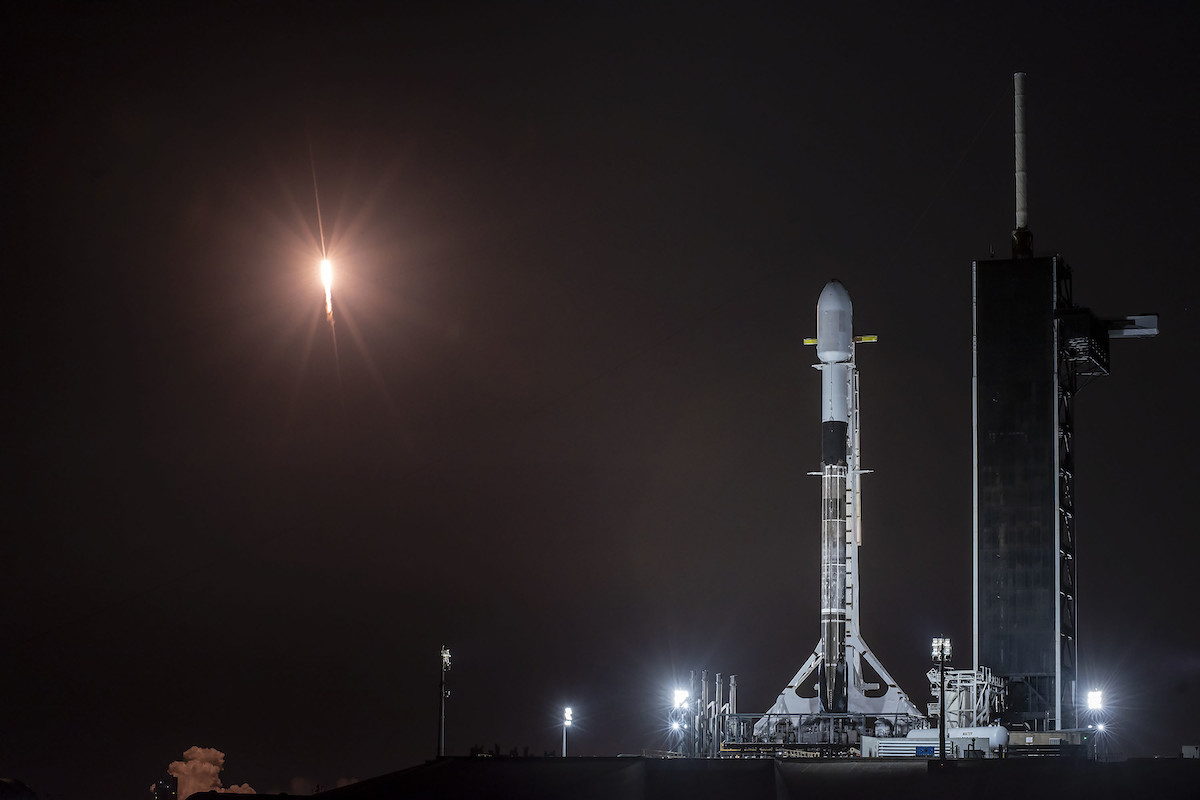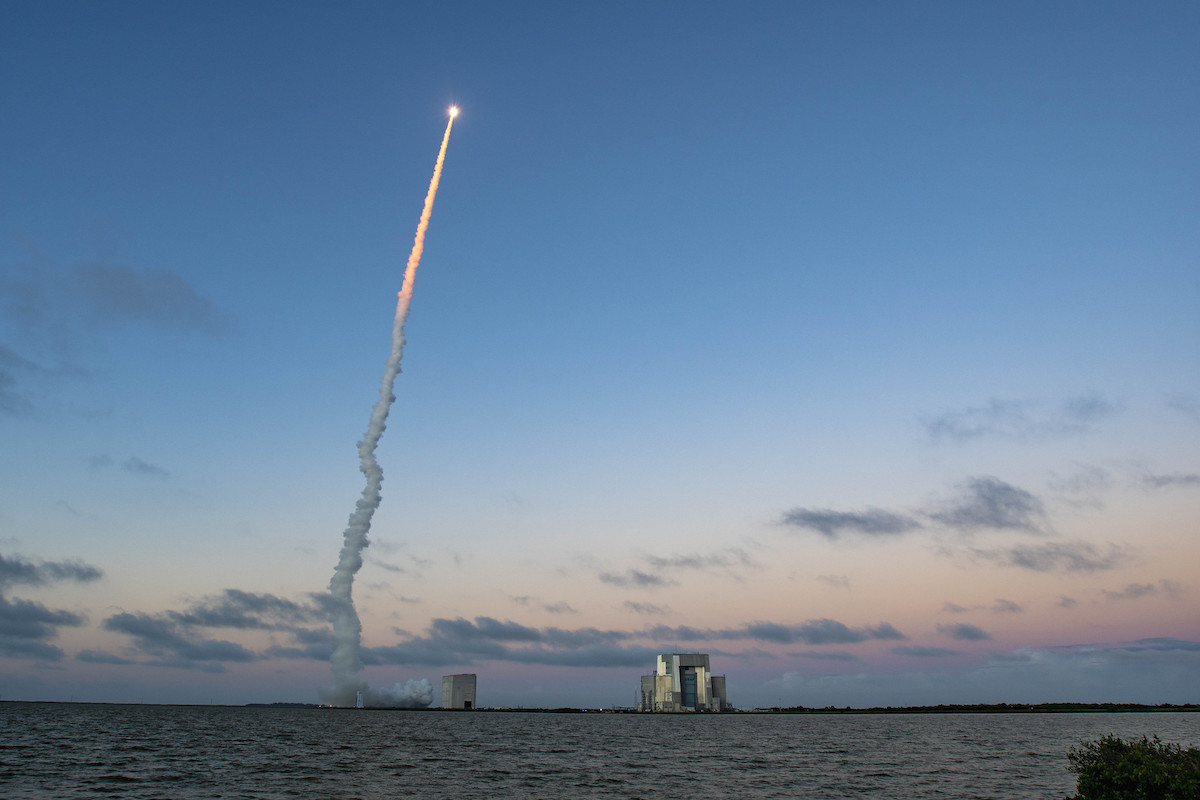EDITOR’S NOTE: Updated Feb. 5 with additional launch delay.

One of the two Falcon 9 rockets SpaceX planned to take off in a span of less than five hours earlier this week will remain grounded indefinitely, preventing Cape Canaveral from hosting two launches on the same day for the first time in decades.
But the military-run Eastern Range was ready for the back-to-back missions, and probably won’t have to wait long for the next chance for a launch doubleheader.
Col. Mark Shoemaker, commander of the 45th Operations Group at Cape Canaveral Space Force Station, said Wednesday that the Eastern Range is ready for quicker turnarounds between launches from Florida’s Space Coast.
The range approved a SpaceX request for two Falcon 9 launches Thursday less than five hours apart, each carrying 60 Starlink internet satellites for SpaceX’s ever-growing broadband network.
SpaceX successfully launched one of the Falcon 9 rockets at 1:19 a.m. EST (0619 GMT) Thursday from pad 40 at Cape Canaveral Space Force Station, but the other mission — set to launch from pad 39A a few miles to the north at NASA’s Kennedy Space Center — was delayed from Thursday to Friday, and then again to Sunday.
On Friday, SpaceX said the Falcon 9 standing on pad 39A will remain grounded to allow teams to perform “additional inspections before flying one of our fleet-leading boosters.” SpaceX said it continues to prep for a Falcon 9 launch from pad 40 as early as late next week with another batch of Starlink satellites.
The delays will allow additional time for “pre-launch checks” before the Falcon 9 takes off from pad 39A, according to SpaceX.
With a jam-packed launch schedule in 2021, it’s likely that the Eastern Range will soon again be asked to accommodate two missions on the same day.
“We’ve said a dozen times over the last eight to nine months that we could do two within less than 24 hours, and everybody … is excited,” Shoemaker said in an interview Spaceflight Now this week. “Then when either the weather or some other factor says no, we’re not going to do it this time, there’s kind of a little bit of a letdown because everybody wants to see it happen.
“We want to see it happen because, frankly, how exciting would that be to see two rockets go off within a real short period of time from the Eastern Range,” Shoemaker said.
In August 2019, a Falcon 9 and an Atlas 5 rocket from United Launch Alliance took off from neighboring pads at Cape Canaveral in a period of less than 35 hours. That was the shortest span between two orbital missions at Cape Canaveral since May 1981.
There were two launches separated by less than 10 hours in 1967, and an Atlas-Agena launch vehicle took off from Cape Canaveral just an hour and 39 minutes before the launch of the two-man Gemini 12 crew on a Titan rocket in November 1966. The Gemini 12 crew docked with the Agena upper stage in orbit.
Launch pads at Cape Canaveral Space Force Station and the Kennedy Space Center supported 31 rocket flights last year, and there are more than 50 missions scheduled in 2021, according to the 45th Space Wing, which oversees the unit commanded by Shoemaker and manages all Eastern Range launch operations on the Space Coast.
The faster launch tempo at Cape Canaveral is driven by SpaceX, which flew 25 of the 31 rocket launches from the Space Coast last year.
“I’ve kind of seen the evolution from when SpaceX first got here, and if we did eight to ten launches a year, we were having a pretty hopping year,” Shoemaker said. “And now we’re looking at upwards of the lower 50s on the calendar for the year.”

Shoemaker said range officials have approved two launches to occur within a 24-hour period a dozen times in recent months.
“Why that didn’t actually happen, whether it was a weather issue that caused a delay, or it was something on the launch provider side that caused a delay, those are things outside of our control,” he said. “Probably a decade ago, we would have said no way, but we’ve really scrubbed the way we do business and focused on how we provide that support to whoever is on the range.”
Military officials have met with SpaceX and ULA, the two major launch contractors flying from the Space Coast, and newcomers like Blue Origin to learn what the commercial rocket companies need from the range.
“One of the things that has helped us get better is the customer base coming in and saying I need you to do more, or I need you to do more, and I need you to do it faster,” Shoemaker said.
“It’s not that we couldn’t have done it a decade ago,” he said. “It’s that the demand wasn’t there. The forcing function wasn’t there.”
Military units at Eastern Range provide safety and security services, manage infrastructure, provide weather forecasting support, and help ensure airspace and downrange waters are clear before launch. The emphasis is on agility and responsiveness to user needs, Shoemaker said.
“When they want to launch, we want to schedule the launch so they can do it. Whether they ask us six months in advance or they ask us a week in advance, we want to get to yes.”
Bad weather and technical factors still get in the way of rocket launches, and Shoemaker said the range approved nearly 200 launch opportunities last year, resulting in the 31 successful flights by SpaceX and ULA.
“So we got to yes 200 times, which is critical,” he said. “I’d say almost every single time somebody asked us to launch we said yep, you can do it. Then a dozen times, we said, yeah, you can do it, and the other customer can do it, and we can do it within 24 hours or less.”
SpaceX’s Falcon 9 and Falcon Heavy rockets fly with autonomous self-destruct mechanisms, reducing the range workforce needed to support a launch. ULA’s Atlas and Delta rockets still use human-in-the-loop flight termination systems, which require a range safety officer to track the launcher’s trajectory and send a manual destruct command if a major problem occurs in flight.
According to Shoemaker, the autonomous destruct systems “allows us a lot more flexibility to move schedules around, and to support activities much more closely spaced.”
“The long term vision is to get to automation of things,” Shoemaker said.
The Space Force wants all space launchers flying from military ranges to have autonomous self-destruct capability by 2025.
The advent of autonomous flight termination systems allows the range to eliminate radar trackers. And the two-way communications links for the manual destruct signal are not required for rockets flying with automated safety mechanisms, such as SpaceX’s Falcon launcher family.
“When you don’t need to call up as much equipment, that’s less time you have to spend configuring that equipment to make sure that it’s ready between one mission to another, so it just provides a significant amount of flexibility,” Shoemaker said. “That has really been fundamental to us being able to say yes all those times we did over the last the last year.”
In the 1990s and 2000s, range officials said they typically needed about 48 hours to reconfigure infrastructure and equipment from one launch to the next.

Gen. Doug Schiess, the former commander of the 45th Space Wing, said last year that the Eastern Range needs about 300 people to support a ULA launch with a manual flight termination system. For a SpaceX mission, with an automated safety system, that number is reduced to about 200,.
Shoemaker said the 45th Space Wing has conducted exercises of the range team to practice how they might support two SpaceX missions in a span of a few hours, or ULA and SpaceX launches on the same day. He declined to say how close in time the Eastern Range might theoretically be able to support two launches.
“I don’t want to pin it down and say we can do (two launches) within an hour, or we could do three within 24 hours,” Shoemaker said.
“The conditions have to be right,” he said. “We could end up in another scenario where they ask us two months from now to do two (launches) within less than five hours, but some external factor that that we don’t necessarily control may drive us to not be able to just say yes.”
National security missions and some NASA launches with limited interplanetary launch windows get priority on the Eastern Range.
The military exercises conducted by the 45th Space Wing have helped identify areas where the range can modify procedures and update processes.
“The exercise is to kind of run to countdowns of two dissimilar launch vehicles with two range crews and understand what do we need to improve upon as far as the training and the way that we execute our parts of the mission, and do deconfliction in between,” Shoemaker said.
Email the author.
Follow Stephen Clark on Twitter: @StephenClark1.



